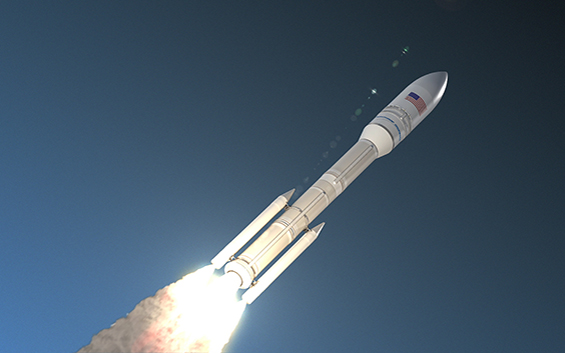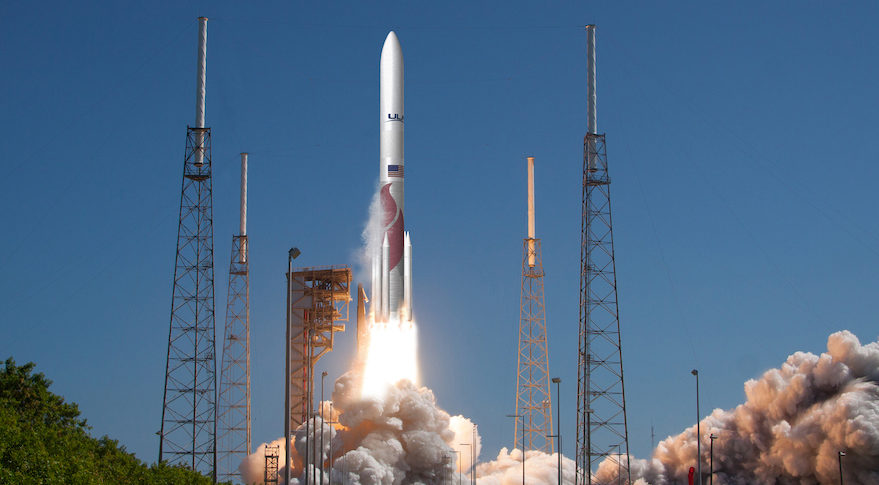The Air Force Launch Plan Must Work
Posted on

Northrop Grumman’s OmegaA proposed rocket
The Air Force has no choice but to pursue the current Launch Services Agreement. The plan is to have the three current launch partners — United Launch Alliance, Northrop Grumman and Blue Origin — work on a $2.3 billion effort to design three space launch variations. The first contract was awarded in October 2018. In 2020, the Air Force will award missions under the Launch Services Procurement (LSP)/Phase 2 competition for missions to be launched from 2022 to 2026. These launches will be divided 60/40 between two launch providers, a carefully considered decision to protect competition and the industrial base. SpaceX, who did not win an LSA development award, will also be able to compete for these LSP launches.
The key reason the Air Force must proceed with this plan? So, the US does not have to rely on the Russian RD-180 rocket engine, which Congress has mandated we stop using by 2020. US space policy, of course, requires we also assure the United States possesses competitive and agile access to space.
The two-phase solution, while not perfect, is the only viable option available given the launch budget available to the Air Force for the next few years.
Too often as my colleagues Tom Karako of CSIS and Rebeccah Heinrichs of the Hudson Institute have noted, endless assessments and studies becomes an alternative to making decisions.
Although Pentagon decisions often are correctly challenged by Congress, in this case the Air Force got it right. For example, as Air Force acquisition executive Will Roper explains, the plan is to make sure there is a competitive industrial base when Phase 2 arrives. Between 2020-24, the Air Force will split five years of launch work between two companies on a 60/40 basis to accomplish this goal. Having at least two industrial partners is required, and it gives the US both competition and stability, as well as assuring the country access to space. And, as Roper has noted, it recognizes the need to grow the industrial base as well.

ULA Vulcan Centaur rocket illustration
Key to the Air Force decision is to recognize its context. As Space and Missile Systems Center chief Lt. Gen J.T. Thompson notes, the planned number of military launches cannot support more than two companies when the AF gets to Phase Two. All of this is also taking place in the context that while the US capacity is now 35 launches a year, the demand for future commercial constellations may hit more than 125 launches annually.
In my view it is reasonable to first build up and sustain the launch business to ensure reliability while working to grow the industrial base to meet what undoubtedly will be dramatic new demands for launch capability.
The current situation arose because the period after the 1986 Challenger disaster and the Titan rocket launcher failures led to a complete shutdown of military launches for one year.
With the end of the Cold War, and a view that commercial space launch work would shift away from the United States, the US needed a new launch vehicle. Seeking to both secure access to space and remain cost competitive, the Clinton administration sought to use the Russian-made RD-180 engine as a means of helping integrate the newly created Russian federation into the international arena. (Eds. note: It is also a cheap and incredibly reliable rocket engine.)
But with the Russian invasion of Crimea in 2014, Congress capped the number of Russian rocket engines we could buy and mandated an end to their use.
The other issue the Air Force is trying to solve is assuring access to space. Only the Delta IV can fly all national security pace missions, meaning if the Delta IV experiences a problem, many of our assets are grounded. The Air Force’s current plan gives other launch providers an opportunity to meet all national security space launch requirements. As Congressman Jim Cooper, new chairman of the HASC strategic forces subcommittee explained in a recent interview, the US does not want to have a “Sputnik moment” when we realize we are dangerously behind our adversaries. Space, as Cooper notes, is a global commons and needs to be protected. While the US has no aggressive intentions in space, Russia and China appear to have “malign intent.” This leads me to a pretty obvious conclusion: we must have assured access to space, but we must also be able to reconstitute our space assets if they are harmed.
The issue of time is why I think the request for a delay by the chairman of the HASC, Adam Smith, is pushing us down the wrong road. In his letter to Heather Wilson, the outgoing Air Force Secretary, the chairman worried that maximizing competition would be lost in the current Air Force approach of “appearing to rush” ahead, a complaint put forward by Space X as well.
We do not have the luxury of waiting around to develop our space launch capability in the best possible manner, because ”lots of time” is exactly what we do not have.
As former Defense Secretary Jim Mattis laid out, we must act with what he called “the speed of relevance”—meaning we have to get new capability into the hands of our soldiers when they need it. And that was yesterday.
Gen. John Hyten, commander of Strategic Command and nominated to be the next Vice Chairman of the Joint Chief, has repeatedly emphasized the need “to go fast” in the development and deployment of our space assets.
As some have noted the bad guys get to vote, and they are not waiting around.
The issue of time is why I think the request for a delay by the House Armed Services chairman, Rep. Adam Smith, is pushing us down the wrong road. In his letter to outgoing Air Force Secretary Heather Wilson, Smith worried that maximizing competition would be lost in the current Air Force approach of “appearing to rush” ahead, a complaint put forward by Blue Origin as well.
However, ULA officials are convinced legacy providers can both innovate and provide “big system integration task”, as well as adopt the Air Force plan which is the “fastest path to end dependency on the Russian RD-180 rocket engine.” Northrop Grumman echoed this view, even noting they could support an acceleration of the schedule.
The contest between speed and agility on one hand, and credible competition and innovation on the other, is not going to go away with the adoption of some perfect acquisition plan — no matter how carefully considered.
Further assessment risks putting the US dangerously behind the proverbial launch eight-ball. Given how much our security relies upon launch services, we simply don’t have time to try an alternative to the Air Force plan. As Wilson has noted: “History tells us what we can do. And do this, we must.”
Peter Huessy, president of defense consulting firm GeoStrategic Analysis, is the Mitchell Institute’s director for strategic deterrent studies.
Subscribe to our newsletter
Promotions, new products and sales. Directly to your inbox.
